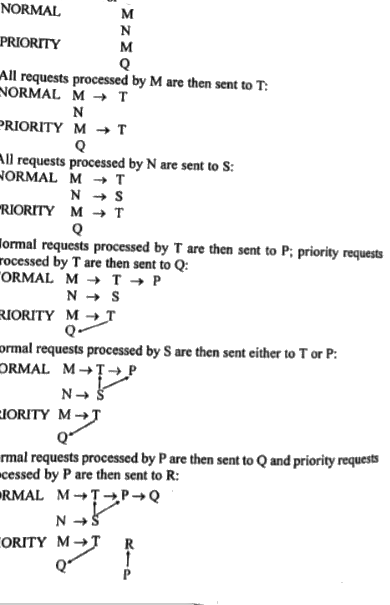An information processing system consists of seven stations - M,N,P,Q,R,S and T. Every request is classified as either normal or priority. Requests for information are processed in the following ways:
(i) All normal requests are received by either M or N, and all priority requests are received by M or Q.
(ii) All requests processed by M are then sent to T.
(iii) All requests processed by N are then sent to S.
(iv) Normal requests processed by T'are then sent to P, priority requests processed by T are then sent to Q.
(v) All requests processed by S are then sent to cither T or P.
(vi) Normal requests processed by P are then sent to Q, and prioriy requests processed by P are then sent to R.
(vii) All requests processed by Q are then sent to either P or R.
(viii) R is the station which issues a final response.
What is the minimum number of stations that must be processed a normal request before the request is sent to R ?
1
2
3
4
The correct Answer is:D
This is a "network" set. Begin by drawing the diagram :
All normal requests are received by either M or N, and all priority requests are received by M or Q :

All requests processed by Q are then sent to either P or R:

The two shortest routes to R for normal requests are: M T P Q R and N S P Q R. In each case, a minimum of four stations must handle the request before it gets to R.
Topper's Solved these Questions
- BOOK - M K PANDEYCHAPTER - PROBLEM SOLVINGEXERCISE - (EXERCISE 20 B)100videos
PROBLEM SOLVING
- BOOK - M K PANDEYCHAPTER - INPUT-OUTPUT(..CONTD):ARRANAGEMENTEXERCISE - PRACTICE EXERCISE41videos
INPUT-OUTPUT(..CONTD):ARRANAGEMENT
- BOOK - M K PANDEYCHAPTER - SYLLOGISMEXERCISE - PRACTICE EXERCISES (TYPE III: EXERCISE 11 C)25videos
SYLLOGISM
Similar Questions
He requested I to go there.
View SolutionAn information processing system consists of seven stations - M,N,P,Q,R,S and T. Every request is classified as either normal or priority. Requests for information are processed in the following ways:
(i) All normal requests are received by either M or N, and all priority requests are received by M or Q.
(ii) All requests processed by M are then sent to T.
(iii) All requests processed by N are then sent to S.
(iv) Normal requests processed by T'are then sent to P, priority requests processed by T are then sent to Q.
(v) All requests processed by S are then sent to cither T or P.
(vi) Normal requests processed by P are then sent to Q, and prioriy requests processed by P are then sent to R.
(vii) All requests processed by Q are then sent to either P or R.
(viii) R is the station which issues a final response.
If a normal request reaches R, what is the maximum number of stations through which that request could have passed before reaching R ?View Solution
Knowledge Check
- Question 1 - Select One
An information processing system consists of seven stations - M,N,P,Q,R,S and T. Every request is classified as either normal or priority. Requests for information are processed in the following ways:
(i) All normal requests are received by either M or N, and all priority requests are received by M or Q.
(ii) All requests processed by M are then sent to T.
(iii) All requests processed by N are then sent to S.
(iv) Normal requests processed by T'are then sent to P, priority requests processed by T are then sent to Q.
(v) All requests processed by S are then sent to cither T or P.
(vi) Normal requests processed by P are then sent to Q, and prioriy requests processed by P are then sent to R.
(vii) All requests processed by Q are then sent to either P or R.
(viii) R is the station which issues a final response.
I.
P II. Q
III. MAI onlyBIII onlyCI and II onlyDI and III only - Question 2 - Select One
An information processing system consists of seven stations - M,N,P,Q,R,S and T. Every request is classified as either normal or priority. Requests for information are processed in the following ways:
(i) All normal requests are received by either M or N, and all priority requests are received by M or Q.
(ii) All requests processed by M are then sent to T.
(iii) All requests processed by N are then sent to S.
(iv) Normal requests processed by T'are then sent to P, priority requests processed by T are then sent to Q.
(v) All requests processed by S are then sent to cither T or P.
(vi) Normal requests processed by P are then sent to Q, and prioriy requests processed by P are then sent to R.
(vii) All requests processed by Q are then sent to either P or R.
(viii) R is the station which issues a final response.
Any of the following can be true EXCEPT .AM sends a request to T.BS sends a request to T.CS sends a request to P.DS sends a request to Q. - Question 3 - Select One
An information processing system consists of seven stations - M,N,P,Q,R,S and T. Every request is classified as either normal or priority. Requests for information are processed in the following ways:
(i) All normal requests are received by either M or N, and all priority requests are received by M or Q.
(ii) All requests processed by M are then sent to T.
(iii) All requests processed by N are then sent to S.
(iv) Normal requests processed by T'are then sent to P, priority requests processed by T are then sent to Q.
(v) All requests processed by S are then sent to cither T or P.
(vi) Normal requests processed by P are then sent to Q, and prioriy requests processed by P are then sent to R.
(vii) All requests processed by Q are then sent to either P or R.
(viii) R is the station which issues a final response.
A periority request could reach R via which of the following sequences ?AM to Q to R.BN to Q to R.CN to S to R.DQ to P to R.
An information processing system consists of seven stations - M,N,P,Q,R,S and T. Every request is classified as either normal or priority. Requests for information are processed in the following ways:
(i) All normal requests are received by either M or N, and all priority requests are received by M or Q.
(ii) All requests processed by M are then sent to T.
(iii) All requests processed by N are then sent to S.
(iv) Normal requests processed by T'are then sent to P, priority requests processed by T are then sent to Q.
(v) All requests processed by S are then sent to cither T or P.
(vi) Normal requests processed by P are then sent to Q, and prioriy requests processed by P are then sent to R.
(vii) All requests processed by Q are then sent to either P or R.
(viii) R is the station which issues a final response.
If a request is processed more than once by the same station, then that station must be
I. P
II. Q.
III. TView SolutionAn information processing system consists of seven stations - M,N,P,Q,R,S and T. Every request is classified as either normal or priority. Requests for information are processed in the following ways:
(i) All normal requests are received by either M or N, and all priority requests are received by M or Q.
(ii) All requests processed by M are then sent to T.
(iii) All requests processed by N are then sent to S.
(iv) Normal requests processed by T'are then sent to P, priority requests processed by T are then sent to Q.
(v) All requests processed by S are then sent to cither T or P.
(vi) Normal requests processed by P are then sent to Q, and prioriy requests processed by P are then sent to R.
(vii) All requests processed by Q are then sent to either P or R.
(viii) R is the station which issues a final response.
Any request that is first received by M and is finally received by R must also have previously been processed by
I. T
II. Q
III. PView SolutionWhich of the following sentences has a request?
View SolutionWhich of the following is a request?
View SolutionSelect the correct direct form of the given sentence.
The boy requested his mother to give him a mango.View Solution

